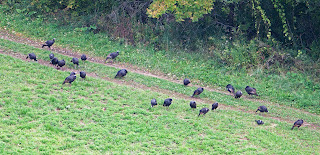NATURE
MONCTON NATURE INFORMATION LINE, Oct. 4, 2021 (Monday)
To respond
by e-mail, please address your message to the information line editor, nelsonpoirier435@gmail.com .
Please
advise the editor at nelsonpoirier435@gmail.com
if any errors are noted in wording or photo labelling.
For more information on Nature Moncton, check the website at www.naturemoncton.com .
Edited by:
Nelson Poirier nelsonpoirier435@gmail.com
Info Line
# 506-384-6397 (384-NEWS)
**One
sparrow we all seek to see in New Brunswick is the Clay-colored Sparrow.
It does breed to the west of us and migrates southerly from there but seems to
seldom visit New Brunswick. Frank branch hit pay dirt on Sunday when he spotted
what was just not like the other sparrows in his Paquetville feeder yard and
sure enough, a few excellent photos of his visiting Clay-colored Sparrow resulted.
We will ask Frank to keep us updated if it lingers.
A pair of Clay-colored Sparrows remained with
Yolande LeBlanc in Memramcook a few winters ago all winter so it is quite
possible with a food supply and protected area for that to happen.
**John
Inman left a hummingbird feeder up as many of us do for straggler migrants or the
possibility of a rare hummingbird species off course. It caught the attention
of a swarm of honeybees that are making good use of it for some late season refueling.
John also
got a beautiful photo of a juvenile Cooper’s Hawk in his yard. The
annual queries of “is it a Cooper’s Hawk or a Sharp-shinned Hawk?” are underway
which can happen in photos not knowing size which is often helpful. However,
John’s photo is easier showing the slender vertical chest lines (of immature ), clearly
rounded tail showing the central rectrices longer than the side rectrices. and bright
white tail band apex.
**Gabriel Gallant spotted some clumps of orange mushrooms on a Dieppe
lawn on Friday. They appear to be the Jack-O’-Lantern Mushroom. This is
a species that could be confused with the chanterelle to amateur collectors.
The Jack-O’-Lantern is toxic and not to be used as an edible. If ID is correct,
it grows in tight clumps which chanterelles never do and the gills are quite
different from the chanterelle when comparing closely. This clump looks to be
quite fresh and would be easier to be more definitive when they get a bit more
advanced. They get the name as they glow in the dark due to a phosphorescent
component. They are much less common than chanterelles.
These comments apply if ID is correct. Photos are good but difficult to
be certain of due to assumedly be freshly emerged.
**Aldo Dorio photographed Honey Mushrooms on a decaying stump
which is their favourite habitat. Interesting to note the spore print is
showing on some of the caps under another cap. It appears as white but is
actually pale yellow as it is falling on a brown background.
**The Nature Moncton visit to Sussex Bluff on Sunday afternoon was a
huge success under sunny skies and pleasant temperatures. A truly special part
of New Brunswick. There were so many items of interest, they will gradually
come out in photos as participants submit them so probably best to make
comments as the photos come in. A huge thank you to Gart Bishop for leading the
wowed participants. Yes, the paths in were root filled and rock formations to
navigate but the group moved so slowly constantly coming upon something to
investigate that no one seemed to mind making the round go much longer than
planned with no regrets from anyone.
A great day in outdoor New Brunswick!
**Am going to quote some of Susan Richards comments:
“Here is a group picture taken Sunday October 3, 2021, of the outing at Sussex Bluffs lead by Gart
Bishop. A dozen people walked a 4-kilometer round trip, about 100 metres
being vertically, on a single path of tree roots, rockface and scree to the
lookout at Sussex Bluffs under a beautiful blue sky on a perfect day with no
wind!! Wind would have been a real fright I would think. Many thanks to
Gart, who lead the way pointing out the plants that grow there and some that
grow ONLY there. Many eyes found many mushrooms and tree species plus
plants, with everyone who attended having had their exercise for the day! “
I suspect many of the very interesting individual items photographed
will be appearing over the next few days as participant photographers get them
labelled. Brian Stone was able to get several group participant photos prepared
that show some of the dramatic background views.
One item in particular was a flock of birds that binoculars could not identify due to distance but made for a lot of head scratching! They were so far away in the valley below; they seemed no bigger than sparrows but some telephoto lens showed them as a flock of Turkeys. These were assumed to be truly wild as Gart pointed out there are at least three known flocks in the Sussex area that are considered truly wild, not a feral blend.
Nelson
Poirier
Nature
Moncton

























